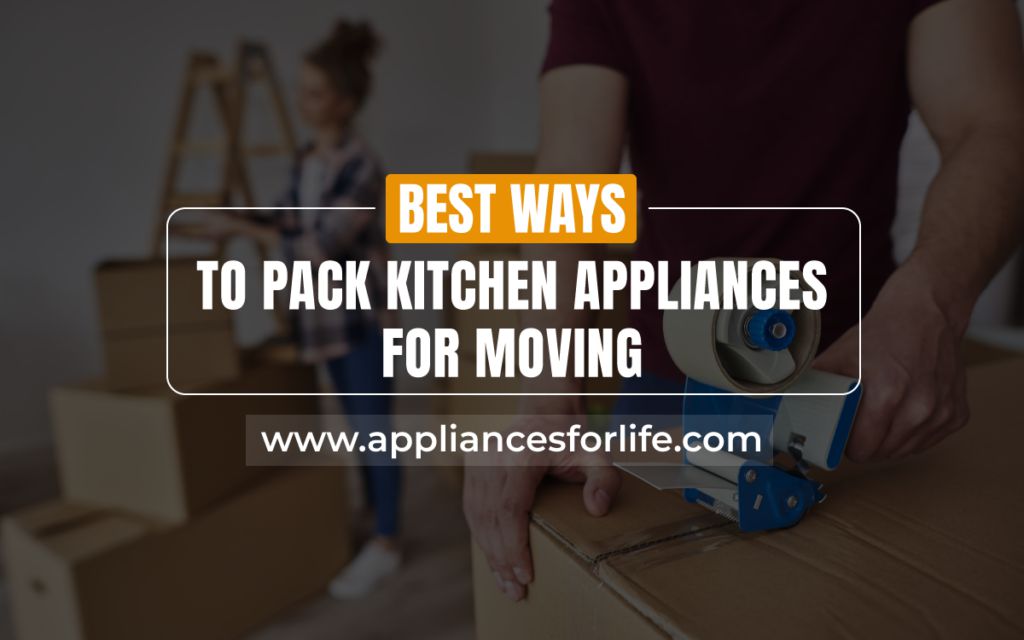I bet you didn’t know that it is necessary for you to take an inventory of the items you are moving to a new location before you commence your packing. You may not be aware also that boxing up smaller appliances and labeling them according to the items they contain is important for identification when it is time to unpack those packed items- It is the ultimate necessity to take to these guidelines in the process of packing your appliances.
Larger items, like a refrigerator, oven stove, and washing machine, need to be treated with extreme care; while they may be built stronger than smaller appliances, improper carriage may cause them to crash into smaller and more fragile appliances, rendering them unfit for subsequent use. A refrigerator should be defrosted, drained, and dried to avoid water leakage that may damage other appliances. All these safety precautions must be taken if one must experience a seamless relocation. Find out more in this article.
Moving to a new residential location requires a lot of strategic planning. After sitting in that perfect new apartment, it is important that you pack your things from the old residence with extreme so as not to destroy them in the process of packing. It is safe to say that when it comes to moving to a new location, packing is the hardest and most time-consuming part. Before we delve deeper, it is essential to know that packing requires time and patience; item organization and arrangement require a lot of caution and care- you want to pack your things according to their functions, room use, and other factors. Hence, keeping track of your belongings during transport and unpacking at the new location always makes sense.
To start with, kitchen appliances should be categorized into small and large. Thus, they
should be packed separately and carefully; if not, you may find the larger ones crashing into smaller appliances. Kitchen and dining cutlery should be packed separately; all the bowls and cups should be kept in a separate compartment to avoid damage or injury while you unpack. It will be a distasteful experience to get a cut from an open knife while trying to lift other items or while running your fingers through the crevices of the van.
Several benefits can be associated with properly arranging your kitchen and general home items before packing; not only will you be able to locate different items when it is time for you to unpack, but unpacking will also not be an onerous task. More importantly, proper and planned arrangement before packing will help you avoid silly accidents- if heavy items and even lighter ones are not properly placed in the carriage van, there is a possibility that items in it come crashing like a house of cards when one of them is removed; trust me, you don’t want a super capacity dryer falling on you or running your fingers through any sharp objects in the van. Lastly, another benefit of planning your packing properly while you move to a new location is to avoid damage to your appliances- you don’t want your washing machine crashing into your delicate microwave oven or your embroided china home appliances.
Packing the Small Kitchen Appliances
Whenever you are getting ready for a big move, the small details are the ones that will make the whole relocation process a bit easier. That includes knowing how to properly pack your small kitchen appliances, not only the big ones. Hence, if you are moving to a new location and intend to do it all by yourself or trying to help a friend out, follow the steps discussed in subsequent sections to have a seamless packing and transition.
What to do before you start packing
Before you commence the packing, it is important that you saddle up; there is no complexity to this at all. However, there are some simple procedures to follow, and they include;
● Clean the appliances and other items you want to pack and dry them properly.
● If certain appliances you want to pack need disassembling, disassemble them accordingly and pack them together; get an appliance repair kit, to achieve this seamlessly.
● In the best-case scenario, you would have the original boxes in which the appliances came. Using them will reduce any potential damage during the move. You will also be able to fit more of the appliances in the big boxes you will put in the removals vehicle.
● Gather the needed packing materials such as packing paper, tape, bubble wrap, scissors, and markers, along with small and medium-sized boxes for moving.
● According to fantastic services, you can be more organized by making an inventory checklist. Write down all the appliances you have and scratch out the name of the ones you have packed. You can also go further by boxing all the items packed, if boxable, and labeling each box by room and its content.
● Do not forget to pack like items together; Start packing each box with a layer of padding – it can be newspapers, bubble wrap, or household goods, like blankets or towels. Then, put the heaviest items into the box first. Note of warning; while you fill those boxes, refrain from filling them to the brim.
How do you pack a coffee maker for moving?
A coffee maker is the kind of appliance that needs dismantling before packing; the truth is, by a stretch, a coffee maker should even be dismantled, if not in use, for proper storage. After dismantling, pack it properly in its box or any other box where it will be safe. If you have the original packaging, there probably is an instruction manual that you can follow when disassembling. If not, you can always check with the manufacturer.
Peradventure, you cannot locate your original coffee maker box. You can use other boxes; only ensure they are two times larger than your coffee maker.
● Fill the box with balled-up packing paper.
● Place a couple of sheets over the coffee maker.
● Wrap it by using the paper on and under the machine.
● Secure everything with the packing tape.
● Put the machine in the center of the box.
● Repeat the packing procedure with the rest of the parts.
● Place them at the corners of the box.
● Fill the rest of the space with more balled-up packing paper.
● Seal the box properly with the packing tape and label it.
How to pack a toaster when moving
A toaster is another small appliance you must pack carefully when moving out. Toasters rarely have any removable parts, but if yours is detachable,
● Place the toaster in the lower right or left part of a packing paper sheet.
● Wrap it and secure each end with tape.
● Now put it on another sheet of paper and wrap it again.
● The more layers of packing paper there are, the safer the transportation will be for your beloved toaster. If you have the original box, ensure the appliance will fit inside with all those paper layers.
● Fill the space with more packing paper, seal the box with tape, and label it.
Additional packing checklist items for each room of the house
1. Empty and Defrost the refrigerator: At least 48 hours before moving, empty your refrigerator and defrost it. Drain all fluid and dry it to prepare the refrigerator for moving. If the goods removed from the refrigerator stand the risk of damage, they can be stored separately in a cooler.
2. Organize dishes: Packing dishes for moving isn’t as hard as you think. Just make sure to pack them carefully by wrapping them in bubble wrap. And refrain from overpacking boxes. Overpacking will make it more difficult to move the boxes, and if a box incurs damage, you could lose a whole grouping of plates.
3. Pack dry goods: Dry goods, especially edible ones, should be packed separately and sealed properly. Tape paper or bubble wrap around seasonings and pack jars containing spices or food on the bottom, so they don’t move around during transit.
How to Pack an oven for moving?
One of the heavy appliances that may need moving is an oven, whether it be gas or electric. It is important to take extreme caution while you do this, especially if your oven is a gas-powered type. Because of how delicate this appliance this, many people tend to get the help of a professional. Regardless, it is possible to do this packing all by yourself, posing no danger to yourself in no way. Follow the steps below to have a seamless packing experience;
Disconnect cord: Remove the plug from the power socket. It might be dangerous having it dangling freely. Tape the power cord at the back of the stove so it’s not in the way and no one trips on it.
The next in line to guarantee maximum safety is the gas connection of your oven if yours is a gas-powered oven/ stove. Carefully connect the stove from the gas source before you commence other detachments.
Remove all detachable: Cooking stoves and ovens come with a lot of detachable, and it is essential that you take them apart and pack them separately. Wrap them with bubble wrap and seal them with packing tape. Place all the parts in a single cardboard box and label “Oven parts.” This way, you’ll save time locating them after the move. Follow this procedure if you are dealing with appliances for grilling food outdoors.
Protect from scratches: Your oven should not have to look all rough and unattractive because you have just moved it to a new location. Hence you have to protect it from scratches. Use bubble wrap on the oven knobs and other protruding parts to prevent scratches. They are at high risk of damage during transportation. Then, wrap the oven with moving blankets from all sides and secure it with packing tape.
How to pack a washing machine for moving
Washing machines usually have a rugged build. Hence they are more resilient to transportation than most home appliances. However, there are packing rules to follow regardless.
Disconnect from power source: Safety is key, even when you pack your washing machine. Unplug the washing machine from the power source and also turn off the water supply. After that, be sure to disengage and drain all water hoses. Hence, there shouldn’t be any residual water left inside the appliance. Additionally, you may dry the interior with a soft cloth.
Clean the filter: You may want to get your appliances straight to work when you reach the new location; in that case, it is important that you put them in a decent working condition by cleaning their filter. More importantly, the function of a filter is to trap dirt that would otherwise block the drain hose/pipe. Therefore, you want to clean it thoroughly so that you do not transport the dirt in the filter to your new location.
Keep the drum steady: The trickiest part of moving a washing machine is keeping the drum immobile during transportation. Otherwise, you risk damaging it. For that, you can use a couple of specialized transportation rods. If you don’t know how to use them, consult a shopping assistant at the appliance store or call your local handyman for assistance.
Protect from scratches: It is essential to keep your washing machine looking smooth while it is in transit- to protect from scratches, tape the power cord or any other extension, like the hose and the pipe, to the back of the washing machine. Ensure that the door of the washer is locked. As the seal is tight enough, you don’t need packing tape to secure it like with the refrigerator. Finally, wrap the washing machine in moving blankets and secure them with packing tape.
FAQs
How do you pack a house appliance for moving?
It is essential to take extreme caution while you pack your home appliances, to avoid damage and injury to oneself in packing. More to appliance safety and the safety of a person is the collection or packing of items for moving. For example, glassware can be packed and boxed together before they are transported. And in the case of glassware, it should be wrapped many times, using bubble wrap or several layers of boxing paper, before boxing the glassware. Every packed box should be labeled for proper identification. Furthermore, an inventory should be made of all items packed so that none is found missing.
How do I pack my kitchen when moving?
Larger boxes are best used for heavy items at the bottom and lighter items on the top. Medium boxes are best used for appliances, pots and pans, and less breakable items. Small boxes are best used for canned food and pantry items. Heavier items should be placed at the base of the box, with lighter items towards the top.
02 HOURS 26 MINUTES
ESTIMATED TIME DESIGNING AND UPLOADING THIS ARTICLE
10 HOURS 26 MINUTES
ESTIMATED TIME RESEARCHING AND WRITING THIS ARTICLE
You Might Also Like

The Best Ways To Make Orange Juice in a Breville Juicer
It is no news that homemade Orange juice has several health benefits. Orange fruits originated somewhere in Southeast Asia. Indeed, the date is as far back as 4,500 years ago. The scientific name for oranges is Citrus Sinensis, one of the most popular citrus fruits.

Top 5 Best Food Processor Brands
Going on the market to purchase a good food processor can be a long process if you don’t already have a brand you can trust. In this article, we’ll be exploring the top 5 best food processor brands in the business today. Experts have said

How many appliances can a 1kw solar panel run
In recent times, the world has been shifting its focus from energy generation methods that are not eco-friendly. International and national laws incessantly discourage over-dependence on fossil fuel and other similar energy generation media. As an alternative to fossil fuels and others, renewable energy, championed

How to Sharpen Nutribullet Blades
If you own a blender and you don’t maintain it properly, it’s only a matter of time before the blender becomes damaged due to lack of proper maintenance. In this article, we’re going to be discussing how to sharpen Nutribullet blades. There’s no better way

HOW TO REMOVE CHEMICAL STAINS FROM STAINLESS STEEL SINK
As opposed to what many people of stainless steel sinks, they can also get stained too. Stainless sinks can be affected by different stains and we’ll be looking at each of those stains in this article. We’ll also be discussing the steps on how to

How To Make Blueberry Juice In A Juicer
As a big fan of juicing, you must have tried several juicing recipes in your juicer. Blueberry juice is one thing people are trying to learn how to make, and our guide for making blueberry juice in a juicer will teach you how to make

How to Load Blenders For Smoothies
As popular as blenders are, a lot of folks are still not familiar with how to properly operate them, leaving them unable to fully maximize their blenders’ functionalities. In this article, we’ll be looking at how to load your blender for smoothies. Your blender, without

What Blender Does Tropical Smoothie Use?
Welcome to the world of Tropical Smoothie, where delicious blends of tropical fruits take center stage. But have you ever wondered how they create these mouthwatering treats? The answer lies in a particular machine known as a blender. These blenders have superpowers that turn fruits

What Are The Most Popular Kitchen Appliances?
Our homes are filled with kitchen appliances, and it’s only normal to be curious about the ones that are needed the most. Having a priority will help you make the best decision if you’re stuck between many options. What are the most popular kitchen appliances?

The Best Rated Kitchen Faucets
When you are choosing the finishing touches for your kitchen such as appliances, faucets and worktops the first thing you look at is style, but is it good quality and good value for money? Our team has searched high and low best rated kitchen faucets for

